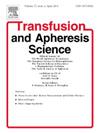从急性肝衰竭患者血浆置换过程中动态蛋白质组变化的试验性探索研究中获得的机制启示。
IF 1.4
4区 医学
Q4 HEMATOLOGY
引用次数: 0
摘要
背景和目的:治疗性血浆置换(PEX)在改善急性肝衰竭(ALF)患者无移植生存率方面具有潜力,但其作用机制尚不清楚。这项探索性研究旨在阐明与 PEX 相关的 ALF 循环蛋白质组变化,以深入了解该疗法的获益机制:2019年6月至2020年8月期间连续入院的ALF患者入组。患者接受标准药物治疗(5 例)或 PEX(5 例)。在多个时间点收集血浆样本,并使用 Olink Proximity Extension Assay 进行分析。比较分析包括健康对照组和 Octaplas 批次:54份样本的生物标记物结果可用:结果:54 个样本的生物标记物结果可用:Octaplas 批次(n = 7)、健康对照组(n = 6)、ALF-标准医疗(n = 8)和 ALF-PEX(n = 33)。对 177 种生物标志物的蛋白质组分析显示,ALF 与健康对照组之间存在明显的基线差异,ALF 患者肝脏分泌的蛋白质水平较低,炎性细胞因子和生长因子水平较高。纵向分析显示了 PEX 的几种不同模式。包括羧基酯酶-1、肝细胞生长因子、胎盘素B、IL-6和IL-10在内的蛋白质在纵向上显示出不同的表达模式,表明了PEX的一些潜在潜在机制和治疗效果:结论:PEX在ALF患者中导致动态蛋白质组变化,反映了其在调节炎症、肝脏再生和替代必需蛋白质方面的多方面作用。这些发现让我们对循环血液蛋白质的一些变化和 PEX 的潜在机制有了深入了解。本文章由计算机程序翻译,如有差异,请以英文原文为准。
Mechanistic insights from a pilot exploratory study of the dynamic proteomic changes during plasma exchange in patients with acute liver failure
Background & aims
Therapeutic plasma exchange (PEX) has shown potential in improving transplant-free survival in acute liver failure (ALF) however the mechanism of action is not understood. This exploratory study aimed to elucidate the circulating proteomic changes associated with PEX in ALF to provide insight into mechanisms underlying the benefit of this therapy.
Methods
Consecutive patients admitted with ALF between June 2019 and August 2020 were enrolled. Patients received either standard medical treatment (n = 5) or PEX (n = 5). Plasma samples were collected at multiple time points and analysed using the Olink Proximity Extension Assay. Comparative analyses included healthy controls and Octaplas batches.
Results
Biomarker results were available for 54 samples: Octaplas batches (n = 7), healthy controls (n = 6), ALF-standard medical treatment (n = 8), and ALF-PEX (n = 33). Proteomic analysis of 177 biomarkers revealed marked baseline differences between ALF and healthy controls, with ALF patients exhibiting lower levels of proteins secreted by the liver and higher levels of inflammatory cytokines and growth factors. Longitudinal analysis showed several distinct patterns with PEX. Proteins including carboxylesterase-1, hepatocyte growth factor, fetuin B, IL-6 and IL-10 showed differential expression patterns longitudinally, indicating some of the potential underlying mechanisms and therapeutic effects of PEX.
Conclusions
PEX in ALF patients leads to dynamic proteomic changes, reflecting its multifaceted role in modulating inflammation, liver regeneration and replacing essential proteins. These findings provide insight into some of the changes in circulating blood proteins and underlying mechanisms of PEX.
求助全文
通过发布文献求助,成功后即可免费获取论文全文。
去求助
来源期刊
CiteScore
3.60
自引率
5.30%
发文量
181
审稿时长
42 days
期刊介绍:
Transfusion and Apheresis Science brings comprehensive and up-to-date information to physicians and health care professionals involved in the rapidly changing fields of transfusion medicine, hemostasis and apheresis. The journal presents original articles relating to scientific and clinical studies in the areas of immunohematology, transfusion practice, bleeding and thrombotic disorders and both therapeutic and donor apheresis including hematopoietic stem cells. Topics covered include the collection and processing of blood, compatibility testing and guidelines for the use of blood products, as well as screening for and transmission of blood-borne diseases. All areas of apheresis - therapeutic and collection - are also addressed. We would like to specifically encourage allied health professionals in this area to submit manuscripts that relate to improved patient and donor care, technical aspects and educational issues.
Transfusion and Apheresis Science features a "Theme" section which includes, in each issue, a group of papers designed to review a specific topic of current importance in transfusion and hemostasis for the discussion of topical issues specific to apheresis and focuses on the operators'' viewpoint. Another section is "What''s Happening" which provides informal reporting of activities in the field. In addition, brief case reports and Letters to the Editor, as well as reviews of meetings and events of general interest, and a listing of recent patents make the journal a complete source of information for practitioners of transfusion, hemostasis and apheresis science. Immediate dissemination of important information is ensured by the commitment of Transfusion and Apheresis Science to rapid publication of both symposia and submitted papers.

 求助内容:
求助内容: 应助结果提醒方式:
应助结果提醒方式:


